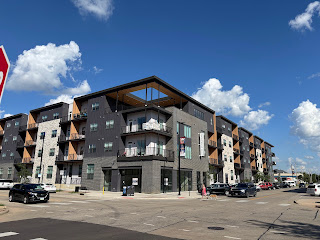How do we make bus transportation more helpful to those who use it, and more attractive to those who don't? Ideas abounded at the open house hosted by the Corridor Metropolitan Planning Organization this week, in advance of their 2019-2024 transportation plan. Without objecting to any of them, and without regard to resource availability or legal constraint, here are my top priorities:
2. Mobile ticketing options. The online bus trackers are wondrous--though occasionally they go funky--and should be accompanied with online ticketing. The $3 day passes are great for busy days, and it's great that they can be bought on the bus. But they do require cash, and drivers don't give change, so if I don't have three singles I make other plans. In the past month or so I have bought tickets online for the I-380 express as well as Metra (Chicago suburban commuter rail), and it takes less than a minute to do. Not everyone has mobile access, but for those who do this is a must.
5. Explore Sunday service. Not everyone works Monday-to-Friday, or even Monday-to-Saturday. Also, many of us attend worship services on Sunday. Are there churches that would be willing to contribute some missions money towards Sunday transit service? For one example, the church I currently attend is near downtown, served by both the #3 and #5 lines. It hosts an Kirundi-language service on Sunday afternoons, to which transportation is a weekly challenge for many attendees from the west side of town. How much would the church need to offer to make this happen?
(I didn't rank "increase sidewalks along transit routes," because that shouldn't even be an issue. The picture accompanying the text is from Wiley Boulevard SW. It was not taken this week, because there's not snow on the ground. It doesn't make sense to build sidewalks everywhere, but where we expect pedestrians to be--and why would you have a bus stop unless you expect pedestrians to be there?--they should be an obvious priority. Congratulations to the city, by the way, for already building sidewalks in many parts of town.)
Promoting transit usage in Cedar Rapids is often a thankless task. About 20 years ago, I attended a City Council meeting where the new public relations staffer for Cedar Rapids Transit was introduced. She talked briefly about her plans for the position, such as encouraging downtown workers to bus out to Westdale Mall (which was still a mall back then) on their lunch hours. She probably eventually found out that it's an hour round trip by bus from downtown to Westdale and back, along a maddeningly circuitous route, which would leave time for neither errands nor lunch. I imagine she left the position soon afterwards, and is now writing fake news stories for Russia Today.
Cedar Rapids is small enough that most car trips are short, is festooned with acres of parking much of which is free, and is so sprawled that an efficient transit service is practically impossible to design. Incremental improvements, such as those advertised at the open house, are not too much to ask on behalf of those who rely on the service, not to mention for the city's resilience in the future.
































